Behind Closed Doors

Underground yeshivos that kept the song alive in times of terror and fear
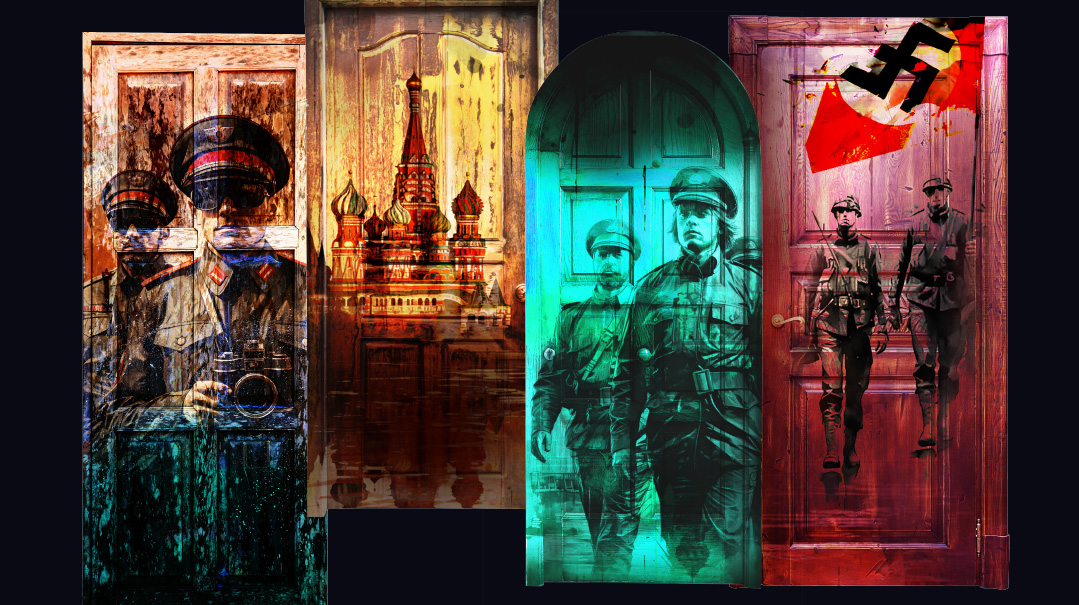
Photos: Mishpacha archives
What does it take to run an underground yeshivah? Students, seforim, a secret meeting place, you might suggest. But how to find a hideout in Communist Russia, when informers lurk around every corner? How to procure seforim in the ghetto, when the Germans have confiscated them all? And how to find students in 1970s Samarkand, when you don’t even know who is Jewish?
Through some of the most terrifying periods of the last century, rabbanim and talmidei chachamim — with the barest resources at their disposal — managed to keep the song of Torah alive. While they sometimes received help from unlikely friends in high places, it was more often than not their characters, imbued with determination, ingenuity, and simple pluck, that enabled Torah study to continue — and even thrive — in the darkest chapters of our recent history.
Soviet Union, 1918
Forced to the Cellars
“The Schneersons don’t run away!”
— Rav Yosef Yitzchak Schneerson, the Rebbe Rayatz of Lubavitch
The Bolsheviks despised religion — the “opium of the masses,” as they called it — and insisted it be stamped out at all costs. But they also despised the czars, and persecuting Jews mirrored the behavior of the czars — which they wanted to avoid at all costs. Their solution: Jewish Communists, who could not be accused of anti-Semitism, would stamp out Judaism for them.
The ”Yevsektsia,” as these Jewish Communists were called, surpassed the Soviet government’s best hopes. They attempted to crush all vestiges of traditional Judaism, even those the Communist government had declared legal. And of all forms of Jewish traditional practice, the Yevsektsia had a particular antipathy for Torah study.
While most yeshivos, seeing the utter impossibility of further Torah growth in the USSR, fled across the border to Poland, one network of yeshivos became famous for its heroic refusal to leave: Lubavitch, under the leadership of Rav Yosef Yitzchak Schneerson, the sixth Lubavitcher Rebbe (also known as the Rebbe Rayatz).
The Rebbe is said to have once told a czarist police officer, “The Schneersons don’t run away!”. Upholding that maxim, the Rebbe organized a massive network of underground yeshivos throughout the USSR — around 600 schools, according to one biographer.
The Rebbe knew that in the trying times to come, he and his followers would need the utmost dedication for their mission to succeed. In a secret ceremony in 1922, he gathered a select group of students, urging them to continue the battle for Torah: “I took eight youngsters who were strong in both body and spirit, and we gathered together in Moscow. There we made a solemn oath: come what may, to persist in our mission, to the very last drop of our blood.”
But in the secret police state that was the Soviet Union, blood was shed to the last drop quickly and frequently. How did the Rebbe and his followers succeed in organizing so many underground yeshivos in such circumstances? “Child guards were placed right outside the doors where learning was taking place, just like in the days of the Spanish Inquisition,” Chabad historian Rabbi Shalom DovBer Levine wrote of the time. “If anyone unfamiliar chanced by, the signal was given: Hide the seforim and stop learning immediately.”
In Novgorod, Rav Chaim Shaul Bruk, a renowned Chabad mashpia in Russia, led an undergound yeshivah in a shul attic. Even though it was stiflingly hot, he taught classes there for hours at a stretch, imbued with the Rebbe’s resolve. And to keep away unwanted visitors, Rav Bruk devised a special code: the bochurim would knock in a prearranged sequence when it was safe to enter and exit the hideaway.
But the attic soon came under suspicion, and Rav Bruk hastily moved the yeshivah to the shul chazzan’s home. It would have been the perfect hideout — except that the chazzan’s son, as it turned out, was a Communist. But Rav Bruk knew that there were two kinds of Communists: the ideological ones, who wouldn’t take bribes, and the opportunistic ones, who would. What type was the chazzan’s son? Fortunately, for the right price, the chazzan’s son was willing to look the other way so that the yeshivah could continue its activities.
But despite the precautions that Chabad leaders took, they faced enormous risks. Yeshivah bochurim were frequently dragged to jail and beaten. In one instance, the Yevsektsia beat a boy suspected of learning in yeshivah, then stood him against a wall in the prison courtyard. A firing squad took aim, the officer gave the command, and rifle shots rang out — but the boy emerged unscathed. The officer had instructed his soldiers to fire just above the boy’s head as an intimidation tactic. The bochur was released, and went back to yeshivah — where he suffered a nervous breakdown due to the trauma he experienced.
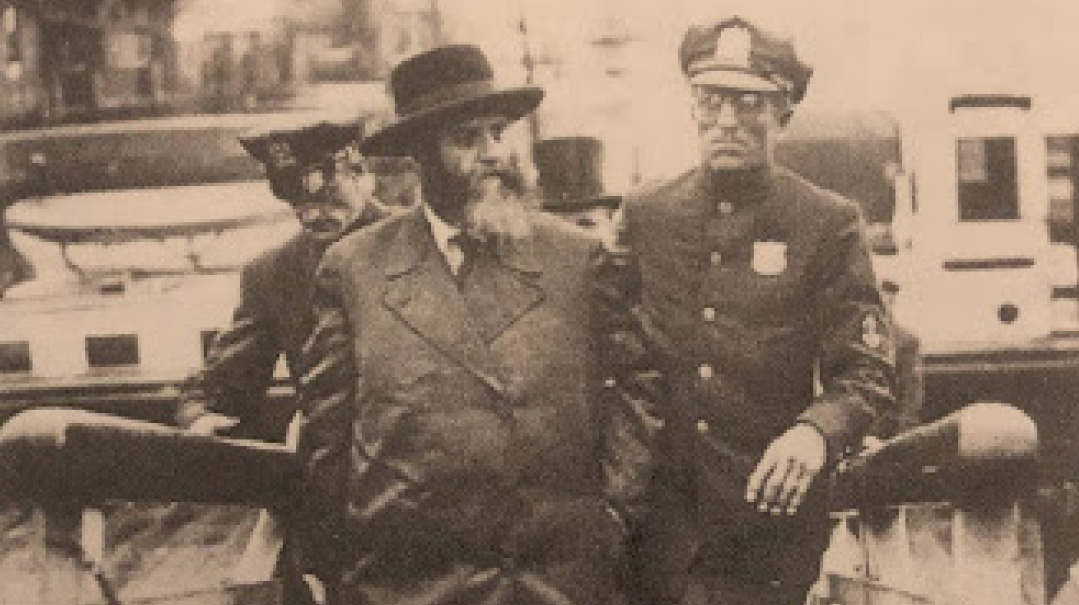
After his release from prison, the Rebbe Rayatz arrives in America in 1929 on a goodwill tour. He would settle there permanently after fleeing Europe at the onset of World War II
IT
was not only the threat of arrest and torture that yeshivah bochurim had to contend with. The young men were hounded relentlessly to give information on their classmates and rebbeim, so the Yevsektsia could build large case files for a mass arrest. Rav Nachum Shmarya Sassonkin, who learned in the Tiferes Bochurim yeshivah in Leningrad, recalled that one day, a boy from Minsk joined the underground beis medrash. He learned well, and joined the young men in all their activities. But Rav Sassonkin recalled that the boys felt “there was something suspicious about him.” Expelling him from the yeshivah could invite further trouble, so they decided to keep an eye on him.
On Yom Kippur, he cried harder than everyone else, and the bochurim wondered what terrible secret he was hiding. It became apparent all too soon. Unable to withstand the terrible pressure from the NKVD (the Soviet secret police, a predecessor to the KGB), he had informed on them — with dire consequences. Rav Sassoskin recounted:
First they imprisoned our maggid shiur, Rav Nachum Terebnik, and exiled him [to Siberia] for three years, in the hope that this would frighten the rest of us into submission. But when they saw that Torah study was continuing just as [it had] before, they decided to imprison all of us.
One evening the Agents of Destruction [i.e. the NKVD] came and imprisoned the whole group, among them my two sons, and they were sent to Siberia for ten years of exile. After enduring brutal conditions in the labor camps, where many perished from hunger and thirst, cold and frost, they were never heard from again.
The Yevsektsia, though, were not content with striking just individual bochurim and yeshivos; they really wanted the mastermind whose will and daring kept it all going. All the evidence — in particular, a voluminous paper trail of correspondece — pointed to the Rebbe Rayatz.
One morning, NKVD agents burst into the shul where he was davening with his chassidim, and demanded that he stop his illegal activities. The Rebbe refused to be cowed by their threats.
One agent aimed a gun at his head and said, “This little ‘toy’ has made many a man change his mind!”
“No,” the Rebbe replied calmly. “This toy can intimidate only a man with many gods and one world. I, however, have one G-d and two worlds — This World and the Next — so I am not impressed by your little toy.”
When continual threats did not succeed in stopping the Rebbe, the Yevsektsia pushed for more drastic measures. Early in the morning on June 15, 1927, NKVD agents, accompanied by Yevsektsia members, arrested the Rebbe in Leningrad. Taken to the infamous Spalerka Prison, he was tortured there for days, and sentenced to death. Even in prison, the Rebbe’s determination for Torah did not waver. Without paper or seforim, he scribbled Torah thoughts on cigarette papers, and when he was told he could not have his tefillin, he went on a hunger strike for two and a half days until they were — remarkably — returned to him.
Eventually, a bevy of highly placed and prominent figures — including Chief Rabbi of Yerushalayim Rav Avraham Yitzchak Kook, US Supreme Court Justice Louis Brandeis, Senator William Borah of Idaho, and even President Calvin Coolidge — pushed for his release. Due to their efforts, the Rebbe’s sentence was commuted to forced exile. He continued his work on behalf of Soviet Jewry from his new home in Riga, Latvia, and later Warsaw, Poland, until the outbreak of World War II led him to American shores.
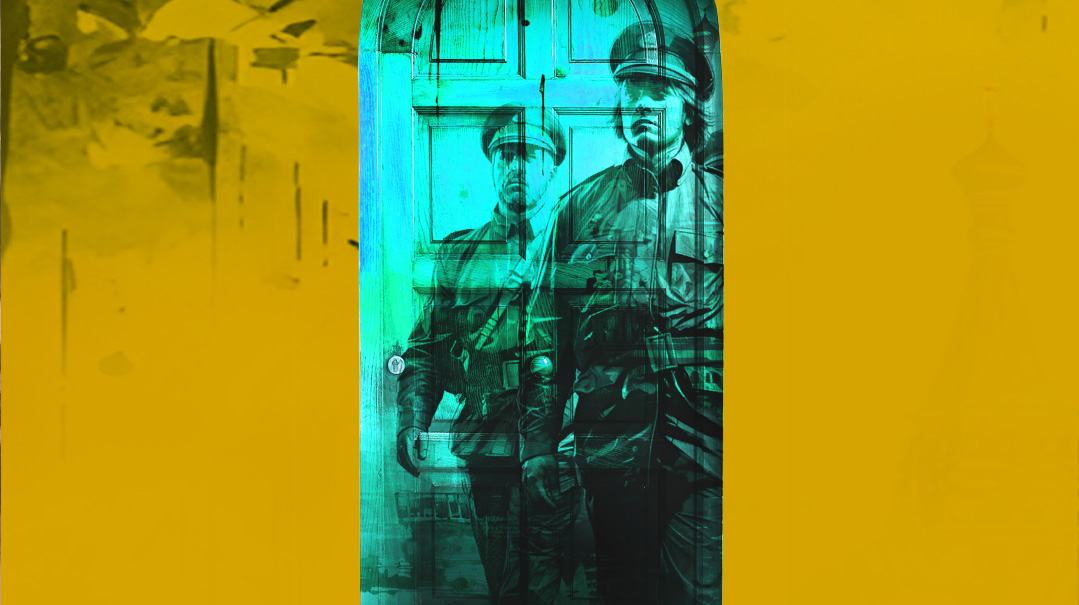
Minsk, 1922
Informants Were Everywhere
“A general must not leave the front in the middle of a campaign”
—The Chofetz Chaim, in a letter to Rav Yehoshua Horodner
W
hile Chabad established some of the most famous examples of underground yeshivos in the USSR, there was another, lesser-known citadel of clandestine Torah learning during the early years of Communist rule: Minsk, in current-day Belarus, said to be “the city with the largest number of [underground] yeshivos in the Soviet Union.” The chief organizer and fundraiser behind Minsk yeshivos was Rav Yehoshua Tsimbalist, also known as Rav Yehoshua Horodner.
When a June 1922 ruling called for closing down all chedarim, yeshivos, and Talmud Torahs, Rav Horodner, a native of Grodno and confidant of the Chofetz Chaim, sprang into action. He first organized a secret yeshivah in the Butcher’s Shtibel of Minsk, but the GPU (another iteration of the Soviet secret police) soon discovered it and shut it down.
Rav Horodner, undeterred, realized that he needed a better hideout — and better safeguards. The Shoavei Mayim shul, located on a quiet side street, was chosen in the hopes that it was hidden from the prying eyes of local Yevsektsia agents. Bochurim stealthily entered in groups of no more than two at a time — large groups automatically aroused suspicion. One talmid kept a lookout at the window for any suspect characters in the vicinity.
As a further precaution, Rav Horodner arranged for the bochurim to learn upstairs in the women’s section, while he, after settling them into their learning, would take a ladder down to the men’s section and teach from there. Why? He reasoned that if they were caught, the bochurim could not be jailed for learning “on their own.”
Rav Horodner’s safeguards were surprisingly effective. The Shoavei Mayim yeshivah had 70 students — the largest of its kind in the Soviet Union. And that wasn’t the only yeshivah Rav Horonder organized and funded — there were at least five others, for various ages, in operation around the city.
B
ut Soviet authorities were not asleep in Minsk. Rav Horodner’s son-in-law Rav Asher Kershteyn wrote that informants were everywhere — in every apartment building and courtyard — and no one knew whom to trust anymore. Anyone who frequented shul was tracked, and soon could lose their job and government aid of any kind. Hitting closer to home, Rav Horodner’s own relative, Rav Yisrael Horodner, gave a drashah in a local shul and was arrested the next day and taken to Siberia. Rav Kershteyn himself was evicted from his apartment with his family and imprisoned for 11 months.
How was it, then, that Rav Horodner was able to maintain a vast underground Torah network in this environment? It seems that he was so beloved in the city — by religious and nonreligious Jews alike — that the Yevsektsia looked the other way. As a rav who spent hours listening to people of all backgrounds relate their troubles, who distributed tremendous amounts of tzedakah raised abroad to the poor of the city, Rav Horodner was seemingly untouchable.
One instance that gives a glimpse of how he earned his reputation in the city was recorded by Rav Moshe Tzvi Neriah, a student at the Shoavei Mayim yeshivah. A police officer once entered the beis medrash and began taking the names of those he found there. Fearing severe consequences for those on the list, the talmidim quickly dispersed. But surprisingly, they reconvened in the Shoavei Mayim shul less than two weeks later.
“The word in yeshivah was that the head of the police, a man by the name of Kroll, was an admirer of Rav Horodner,” Rav Neriah wrote. “Since Rav Horodner had a reputation in Minsk as a tzaddik, a gomel chesed who helped every needy person in the city, Kroll ignored the yeshivah.”
And another example from Rav Neriah, witnessed as he passed by the yeshivah one summer day: “Rav Yehoshua was sitting and learning, and called out to me, ‘Two plumbers are working now in the building, tell them to come to me when they are finished.’ He added with a smile, ‘The women will quibble with them about the price and lower the wage for their work. So I want to make sure they are paid in full.’”
But successful as Rav Horodner was, the situation in the Soviet Union was becoming increasingly dire by the end of the 1920s. Rav Horodner had applied for an exit visa for Eretz Yisrael back in 1924, but the Chofetz Chaim had then forbidden him to leave, writing: “A general must not leave the front in the middle of a campaign.” Yet by the early 1930s, it was clear that Yiddishkeit had no viable future in the Soviet Union. Rav Horodner made aliyah in 1933 and continued working on behalf of Soviet Jewry from Eretz Yisrael.
“Even great people gave up hope,” wrote Rav Neriah, who later became a rosh yeshivah in Eretz Yisrael. “They saw everything being destroyed, so they didn’t even try to mount a defense… But not he.”
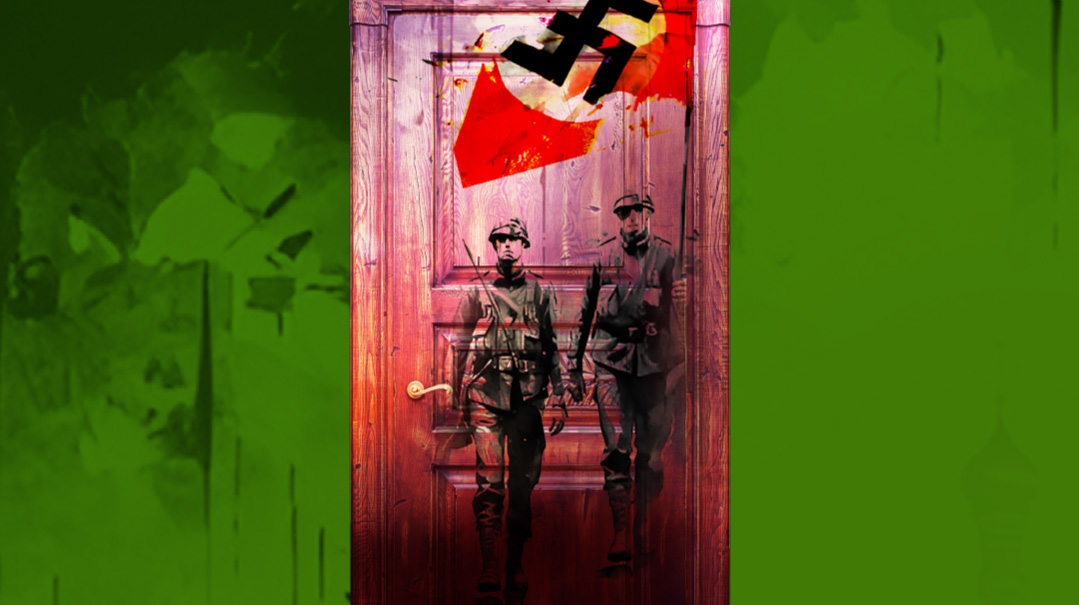
Warsaw, 1940
Learning on the Job
“The amazing sight that meets me reminds me of the age-old stories of Tannaim learning in caves or the Marranos secretly practicing Judaism under threat of the Spanish inquisitors”
—Hillel Seidman, describing a yeshivah hidden in the ghetto
O
ne might expect the Nazis to have promulgated edicts against Torah learning, given their hostility to Jews. And rabbanim in the ghettos certainly took care to keep their batei medrash hidden. But whereas the decrees issued by the Communists served their goal of eradicating religion, the Nazis had a different objective.
“The Nazis cared little about Torah learning in the ghetto — their primary concern was annihilating the Jews,” says Yehuda Geberer, Mishpacha columnist and Yad Vashem guide. “Because the Jews in the ghettos — based on a long history of anti-religious persecution — perceived that Torah learning was forbidden, going underground just made sense.”
Whether there was an official edict against Torah study or not, hundreds of secret yeshivos were in operation throughout Nazi-occupied Europe. And it should come as no surprise that Warsaw, Poland — with the largest prewar Jewish population in Europe — was the center of this underground yeshivah movement.
There were so many rabbinic leaders in the Warsaw ghetto that it is hard to pin down one particular figure who led the underground yeshivah movement. But without doubt, Rav Menachem Ziemba played a central role. In the words of Hillel Seidman, a frum archivist and diarist in the Warsaw Ghetto, “Rav Menachem Ziemba was the guiding spirit behind all these projects.”
Rav Ziemba visited clandestine yeshivos throughout the ghetto — in “‘bunkers and bolt-holes, in cellars and attics ,” and tested bochurim in their learning, giving them chizuk to continue despite the horrific circumstances. Rav Ziemba was given a chance to escape, but he refused. He chose to remain with Jews of the ghetto and give them what strength he could in those agonizing times — and unfortunately perished with his beloved brethren in the Treblinka concentration camp.
One of the many underground yeshivos in the Warsaw ghetto that Rav Ziemba was involved with was officially not hidden at all. It was in a leather factory — the Schultz factory on 46 Nowolipie Street, run by Reb Avraham Hendel, a chassid of the Sokolov Rebbe. Hendel, as manager, had the right to hire his own workers — which, due to the permits this conferred, was lifesaving in the ghetto. Risking his life countless times, Hendel chose to employ the leading Torah sages and scholars of the ghetto, “men who barely knew how to hold a hammer,” in one survivor’s words.
But Hendel was not acting alone: Rav Ziemba, as Hendel recalled after the war, stopped by the factory frequently, not only to speak in learning with the rabbanim there, but also to ensure, to the best of his limited ability, that they were safe. “He [Rav Ziemba] became the source of assistance, and was also the hub for all other activists,” Hendel recalled.
Due to Rav Ziemba and Avraham Hendel’s efforts, the leading lights of Torah Jewry were able to continue studying Torah in one of the darkest times in our history. Hillel Seidman visited the Schultz factory and described the scene:
At one workbench, officially repairing shoes… sits the Kozhiglover Rav, Rav Yehudah Arieh Frumer, formerly rosh yeshivah at Chachmei Lublin. He might be sitting here, but his mind is miles away; his lips are constantly moving, obviously he is studying Torah by heart. Every so often, he throws a question to his neighbor opposite, the Piaseczna Rebbe, Rav Kalonymus Kalman Shapiro, author of Chovas Hatalmidim, and they begin a whispered dialogue in Talmudic study quoting Chazal and poskim… [Another scholar, Moshe Pinchas Hertz] quotes Rambams, Rans, and Tosafos to all comers. But there is an urgent need to restrain him — any minute the SS may reappear.
One night, the SS did appear — and it seemed like all would be lost. Hendel , who survived the war, recounted that once, in the middle of the night, Herr Schultz’s Nazi commissar Paul showed up at the workshop for a surprise inspection.
The Krimilover Rebbe, Rav Nosson Nochum Rabinowitz, was supposed to be sorting leather scraps on his night shift, but instead was sitting on the floor and studying Zohar from memory. So absorbed in learning was he, in fact, that he did not sense Paul’s entry to the workshop. Paul grabbed the rav, stood him against a wall, and commanded the rest of the workers to come witness what happens to those who engage in “sabotage.”
Hendel, apprised of the situation, jumped out of bed in his pajamas and ran to the factory — and not a moment too soon. Paul had his gun aimed at the rav’s back, his finger on the trigger. In the heat of the moment, Hendel grabbed Paul’s arm and wrenched the gun from his hand. Paul could have turned Hendel in to the Gestapo for his audacity — but he did not. He could have turned all of them in, in fact, but he did not — and miraculously that night, all the rabbanim at the workshop were saved.
The underground yeshivah organized by young Gerrer chassidim in the Warsaw Ghetto — which was also assisted by Rav Ziemba — was entirely different from that in the Schultz leather factory. Not only did the Gerrer bochurim learn in secret, their entire existence in the ghetto was secret. Wary of the fate awaiting those who officially registered with the Germans, they lived off the radar — and could not obtain jobs or the life-saving ration cards that accompanied official work permits. Instead, they spent their days and nights learning in secret locations throughout the ghetto.
Hillel Seidman, who used his position on the Judenrat to help bochurim in the ghetto, visited the Gerrer underground yeshivah, and described in vivid detail the secrecy and ingenuity involved in reaching the secret bunker:
We pass through one courtyard after another until we descend down two stories and seem to walk for ages through endless cellars. Finally we emerge at 11 Kopeicka Street and begin climbing stairs until we reach a small room. From here a ladder leads to the attics, and now we walk from one attic to another, squeezing through narrow breaks in the party walls….
We enter a room that used to house a small shtibel and then an adjacent room with a large fireplace. My guide climbs into this fireplace and vanishes! Puzzled, I wait outside until I receive that peremptory call again: “Come!” Gingerly, I crawl after him into the hearth and realize that a breach opened at the back leads down to the cellars. I descend via a hanging rope ladder that apparently has rungs without end.
While a “bunker” connotes a cramped and uncomfortable hideout, Seidman writes that in a feat of ingenuity, the yeshivah bochurim managed to equip the underground yeshivah with modern conveniences: electric lights, gas, running water, and a waste-disposal system. But what he found more astonishing than the engineering complexity of the bunker is the Torah learning taking place there:
The amazing sight that meets me reminds me of the age-old stories of Tannaim learning in caves or the Marranos secretly practicing Judaism under threat of the Spanish inquisitors.
But this is not an ancient story. It is happening, here, in front of my own eyes. About 20 bochurim are sitting at a long table in front of open Gemaras. They are learning with great hasmadah, with all their energy and concentration…
Bella Scharfherz, a Warsaw ghetto survivor, heroically brought much-needed food to the bochurim learning in the Gerrer bunker. Only after following a labyrinth of courtyards, corridors, and steps, and giving the correct password was she admitted to the clandestine yeshivah. Bella recounted:
I’ll never forget that bunker. The cellar was divided into several small rooms. The whole place was lit by carbide lamps. There were Gemara volumes and other holy books all over the place. The men sat there, studying with great enthusiasm…. If you ask me, those boys who studied in that bunker were as brave and daring as any of the ghetto fighters.
The Bais Yaakov of the Warsaw Ghetto
The Warsaw ghetto was not only home to underground yeshivos, but to an underground Bais Yaakov network as well. Without textbooks, workbooks, or heating, with barely any food to keep them going, young girls would congregate in secret “classrooms” throughout the ghetto to gain inspiration from their Bais Yaakov teachers. Gutta Sternbuch (née Eisenzweig), a Bais Yaakov Seminary graduate, was appointed headmistress of the ghetto Bais Yaakov at age 23. In her memoirs, Gutta recalled the hideaway she used for her classroom:
My classroom was in a house that had been half-destroyed by the bombing. We would climb a ladder up one flight, and although this climb was a little frightening, once upstairs, after we had pulled the ladder up after us, we felt as though we were in an enchanted, protected world, where no one could reach us. We were like queens, free and distant from the terrible reality of the ghetto. We used to call our hideaway “the cave.” It was like the cave of Rabi Shimon bar Yochai, a hidden bastion of Torah in face of persecution.
Without textbooks, and with cold and hungry charges, the Bais Yaakov teachers focused on inspiring their students with stories, singing, and words of hope. And the teachers themselves drew their own inspiration from Rav Yehudah Leib Orlean, prewar head of the Bais Yaakov Seminary in Krakow, who gave shiurim on Mishlei, Nach, mussar, and Jewish thought. His shiurim were so popular, writes Hillel Seidman, that they quickly outgrew his apartment and had to be moved to a larger venue. In early 1943, Rav Orlean was transferred to Bergen-Belsen, where he continued to give classes in Tanach and other subjects. He was later transferred to Auschwitz, where he perished.
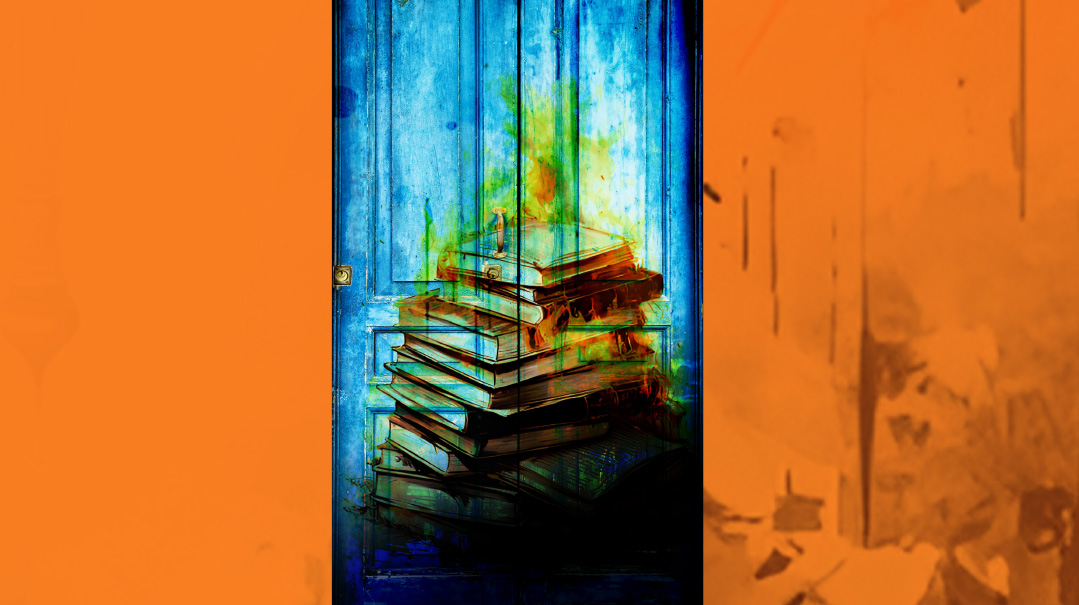
Kovno, Lithuania, June 1941
Better to Die Holding a Sefer
“After [learning], we davened Minchah, and then the owner of the house gave each of us one slice of bread and a small plate of boiled beet cubes for Seudah Shlishis. To us, this was a taste of Gan Eden!”
—Rabbi Yitzchak Elchanan Gibraltar
W
hile Warsaw came under the Nazi boot right at the onset of World War II in 1939, it was not until almost two years later that Kovno, Lithuania, met the same fate. Kovno — home to one of the crown jewels of the Torah world, the Slabodka Yeshivah — would be the site of some of the greatest brutality of the war, and also some of the greatest mesirus nefesh for Torah learning throughout the years of the Holocaust. Slabodka’s roshei yeshivah and talmidim would form the nucleus of the underground yeshivah movement in the Kovno ghetto.
Kovno was also home to one of the most famous rescue operations of the Holocaust. In the early days of the war, before the Germans marched into Kovno, Japanese consul Chiune Sugihara — together with Dutch consul Jan Zwartendijk — heroically signed thousands of transit visas for Jews fleeing the Nazis (including nearly the entire Mir Yeshivah). But tragically, it was mostly Jewish refugees from Poland who swarmed Sugihara’s office. Kovno’s local Jews, believing they were safe, did not take advantage of the windfall in their own backyard. Lulled into a false sense of security, they remained behind — to fateful consequences.
On June 22, 1941, the Germans invaded Lithuania and unleashed a wave of brutality across the country. Acting in tandem with their German overlords, within three days of the invasion, a mob of Lithuanian fascists, accompanied by local citizens, massacred over 800 Jews in Kovno’s suburb of Slabodka. For Rav Ephraim Oshry, a young rav in the ghetto, one of the most shocking parts of the tragedy was that one of the leaders of the bloodbath was none other than Kovno’s long-time Shabbos goy. If he had turned against them so cruelly, Rav Oshry felt, who knew what lay ahead for them?
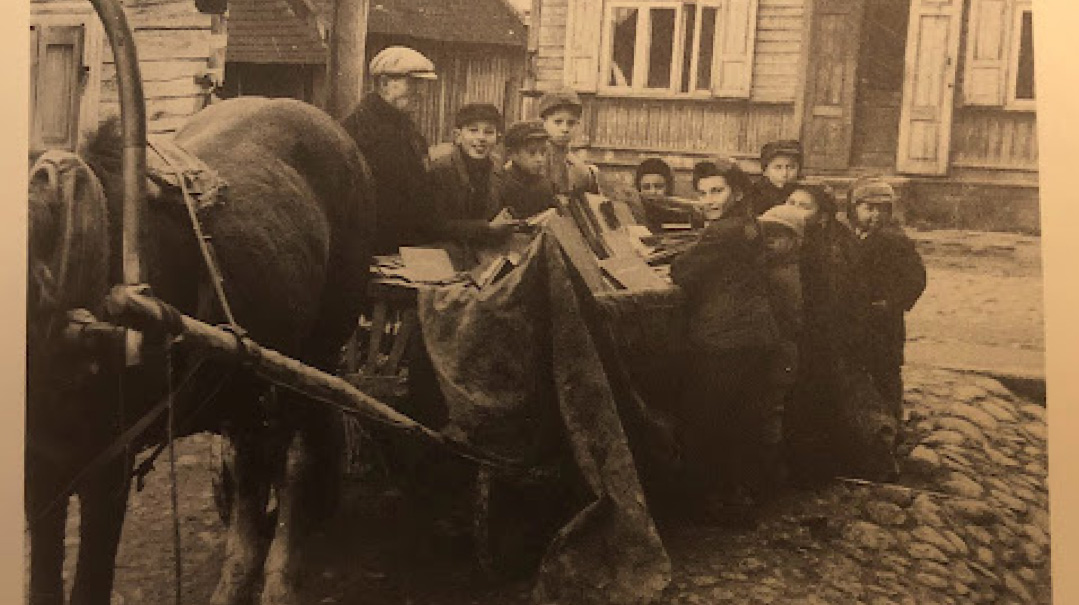
Kovno’s talmidei chachamim continued to learn, despite the horrific fate that overshadowed them, collecting seforim that would be hidden in the ghetto
Within days of the German invasion, most of the Slabodka yeshivah’s rebbeim and student body had been dispersed or murdered, and the yeshivah closed its doors. But the Kovno talmidei chachamim continued learning, despite the horrific fate that overshadowed their lives. Rav Avraham Grodzinski, the head of Slabodka yeshivah, offered his apartment at 15 Poneru Street, where a group of rabbanim, students, and teachers — among them Rav Elchonon Wasserman — gathered in overcrowded, grim conditions to study Torah. The improvised yeshivah, though, lasted less than two weeks. Rebbetzin Rivka Wolbe, Rav Grodzinski’s daughter, recounted how it was brutally disbanded:
One morning, three rifle-bearing Lithuanian partisans suddenly burst into the building. Rav Elchonon Wasserman was standing the hallway, studying with his chavrusa. I remember how, in the few weeks he stayed in our building, he would learn standing up. The sight of male Jews, especially rabbanim who were still studying Torah, incensed the Lithuanians. They screamed, “Don’t move,” and threatened the men with their guns.
Wildly, they ran from apartment to apartment, from room to room on the ground floor; then they went upstairs, where they searched the second floor. They gathered all the men they found and dragged them outside. A few men managed to hide and were not discovered. With beastly shouts, the partisans hustled the 13 men into the yard… Heading the group was Rav Elchonon Wasserman.
Rav Elchonon fortified the men with reflections on the mitzvah of kiddush Hashem. They were murdered that same night in the Seventh Fort outside Kovno.
If, after the initial days of terror, Kovno’s Jews thought things could get no worse, they were mistaken. In early July, the Germans issued a new edict: All of Kovno’s Jews were required to move into the newly formed Slabodka ghetto, which had room for less than a third of the Jewish population. In the ghetto, they faced new horrors: overcrowded, unsanitary conditions, starvation rations, and worst of all, ruthless aktions, which led to mass graves in the nearby Ninth Fort. The atmosphere in the ghetto was so bleak that Jews took to using a new farewell upon parting from each other: “Auf wiedersehen in yenner velt” (“See you in the next world”).
Against this backdrop of terror, and at tremendous risk, yeshivah students and rebbeim were determined to continue Torah learning in the ghetto. The Slabodka yeshivah building, even if they would consider using it, was not an option — it was now being used as a concert hall, to the anguish of many former talmidim. But rebbeim and talmidim found other locations to regroup and keep learning.
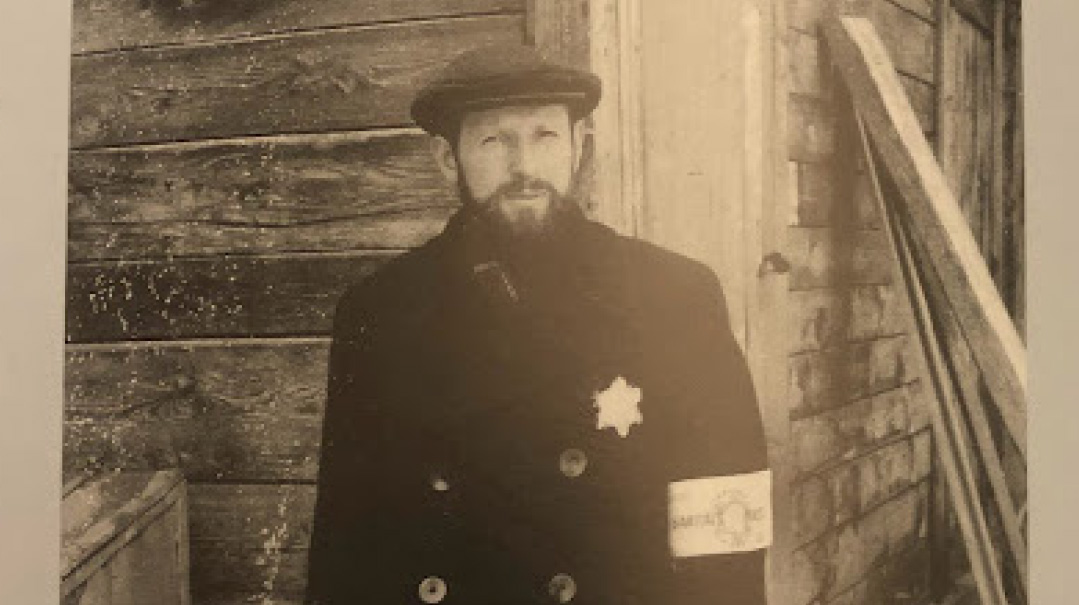
Rabbi Ephraim Oshry: If the long-time Shabbos goy had turned on them so cruelly, what else lay ahead?
Rav Grodzinski, who had been spared in the earlier raid, continued to offer his apartment for learning. According to Avraham Tory, an archivist in the ghetto, Rav Grodzinski’s students begged him to cease teaching and hide himself, but he refused. Rav Grodzinski replied to their pleadings that “on the contrary, this was the right time, the time of emergency, to study the Torah. If we are doomed to die… it is better to die with the book of the Torah in one’s hands .”
Torah study in the Ghetto became even more precarious in late February 1942, with the passage the infamous “Book Aktion.” All books — secular and religious, including sifrei Torah — had to be turned over to the German authorities by February 28, on penalty of death. Rabbi Yitzchak Elchanan Gibraltar, then a 14-year-old Slabodka student, remembered the desperate questions this raised for talmidim: “The question was, what to do with sifrei kodesh? We went to the rav of Kovno, Rav Avraham DovBer Kahana Shapiro, to ask what to do. He advised this: ‘[On the day of the deadline,] light the oven, and put the seforim on the table. And we will see — if they come to search houses for books, then we’ll immediately burn everything. But if the Germans are satisfied with what was brought to them voluntarily, then we’ll keep the rest.’ In the end, we were able to keep all of the seforim.”
If yeshivos in the Kovno ghetto had initially gone underground due to fear of Germans targeting rabbanim and yeshivah students, in August 1942, the need for secrecy became a fact. Stadtkommissar SA-Coloner Hans Cramer issued the following decree on August 25, 1942: “Existing schools are to be closed immediately; the staff employed in the schools is to be directly integrated into the labor brigades. Any form of instruction as well as conducting religious services is immediately prohibited.”
The decree, though, did not deter the determined. All throughout the ghetto — in freezing attics, bunkers, and basements, Torah study continued. Rabbi Gibraltar attended the underground Tiferes Bochurim yeshivah and described the difficulties students faced: finding a suitable place to learn, and teaching boys who were so hungry they could barely concentrate on the Gemaras in front of them. “We gathered on Shabbos — around forty boys — and sat in a small room squashed on beds around a table. HaRav Mordechai Pogromansky taught us, and to tell the truth, we didn’t understand a word of of what he said,” Rabbi Gibraltar recalled.
“After [learning], we davened Minchah, and then the owner of the house gave each of us one slice of bread and a small plate of boiled beet cubes for Seudah Shlishis. To us, this was a taste of Gan Eden!”
After moving constantly from one hideout to another, Rav Ephraim Oshry finally found a long-term residence for the underground yeshivah — an unfinished basement piled with rubble. The bochurim cleaned it out, hauled in benches, tables, and an aron, and ghetto residents celebrated the yeshivah’s opening with a clandestine chanukas habayis. Residents across the ghetto were so excited about the yeshivah that one of the ghetto’s Jewish police chiefs, Ika Greenberg, agreed to serve as lookout for passing German patrols during the opening ceremony.
But the joy of finding a permanent home for the yeshivah was dimmed by the constant terror the boys lived with if they were found out: “We knew that if the Gestapo men… found us learning Torah,” Rabbi Gibraltar wrote, “we would be in tremendous danger. They would unquestionably take us all to be killed in the Ninth Fort.” So in addition to the benches, tables, and seforim, the boys constructed an escape route hidden in a corner behind the aron, in case of a surprise German visit.
A friend of Rabbi Gibraltar’s, while walking with him in the ghetto one day, exclaimed : “I don’t have the chutzpah to ask Hashem to give me life, with Jews being slaughtered by the thousands every hour. Am I any worthier than they are? But that I shouldn’t be zocheh to learn Torah in yeshivah? Ribbono shel Olam, that I am not willing to give up on.”
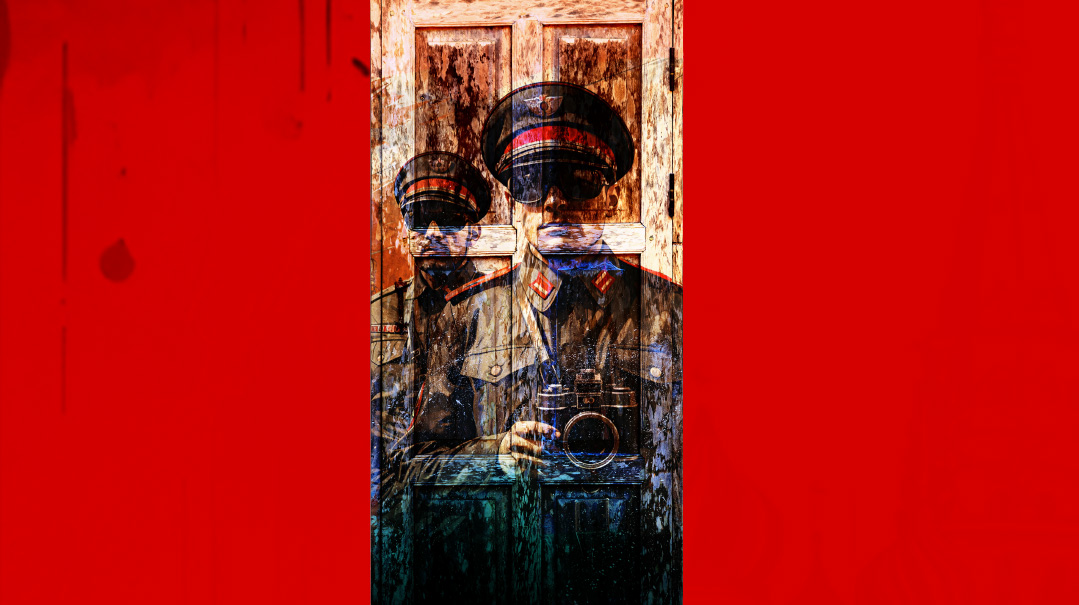
Uzbekistan, 1960s–’70s
Undetected
“Shlomo! What are you doing wearing bell-bottoms?”
—A shul gabbai interrogating Rav Shlomo Chai Niyazov, then a bochur, who snuck out of a military hospital to join a secret minyan
S
amarkand, a city in the Bukharian region of Uzbekistan in Central Asia, has a Jewish community that dates back to the Persian Empire. The city fell under Imperial Russian rule in the mid-19th century. And when the Communists took over Russia in 1917, Samarkand, along with other Bukharian cities, fell under Soviet rule as well.
But the anti-religious campaign that plagued Jews of Russia proper did not reach far-off Samarkand right away. In the early years of their regime, Soviets allowed for religious practice to continue uninhibited, perhaps due to the fact that Bukharian Jews had welcomed them after years of Muslim persecution.
For Bukharian Jews, this window of religious freedom provided an unexpected benefit — many Chabad rabbanim and teachers, fleeing Russia proper (and later fleeing the German onslaught during World War II), escaped to Samarkand and nearby cities during these years. Building upon the success of earlier Chabad shluchim to the region, these new rabbanim created a strong religious infrastructure that enabled Torah study to continue — even through the trying times to come.
While anti-religious persecution waxed and waned in Samarkand in the decades following World War II, the 1960s and ’70s — under Soviet premier Leonid Brezhnev — were particularly difficult. The KGB monitored every move of the local Jewish population, and religious practice was severely curtailed. Bukharian children could not receive Jewish education, attend shul, or even own seforim.
Rabbanim needed every ounce of resolve — and creativity — to continue Torah learning in the city. At one clandestine Chabad gathering, for instance, the group leader had to figure out how to get the sefer Tanya to the meeting point. So, thinking quickly, he stashed the sefer inside that day’s edition of Pravda (the official Communist newspaper) — and made it without mishap.
But Torah education of children was by far the most dangerous activity. Rav Isak Abramov, currently rav of Shaarei Tefillah in Kew Gardens Hills, New York, related in a conversation with Mishpacha that in 1967, when he was 11 years old, his mother secretly took him to an elderly rav in Buchara to prepare for his bar mitzvah. Local informers, aware of the rav’s illicit teaching, accosted him and threatened to turn him in to the KGB.
“What is there to be afraid of?” the rav replied. “I am 87 years old. I have one leg in This World and one already in the Next, so what more can you do to me?”
Recognizing defeat, the informants backed off, and young Isak Abramov received a rudimentary bar mitzvah training in semi-secrecy.
Shortly after his bar mitzvah, though, when Rav Abramov’s mother passed away, things became much more complicated. He and other shul congregants had to use all their ingenuity to come up with a plan to avoid discovery while he recited Kaddish. Young Isak would crouch between elderly men, who were permitted to daven in shul, and this way he managed to say Kaddish for some time — until one day an informant noticed him.
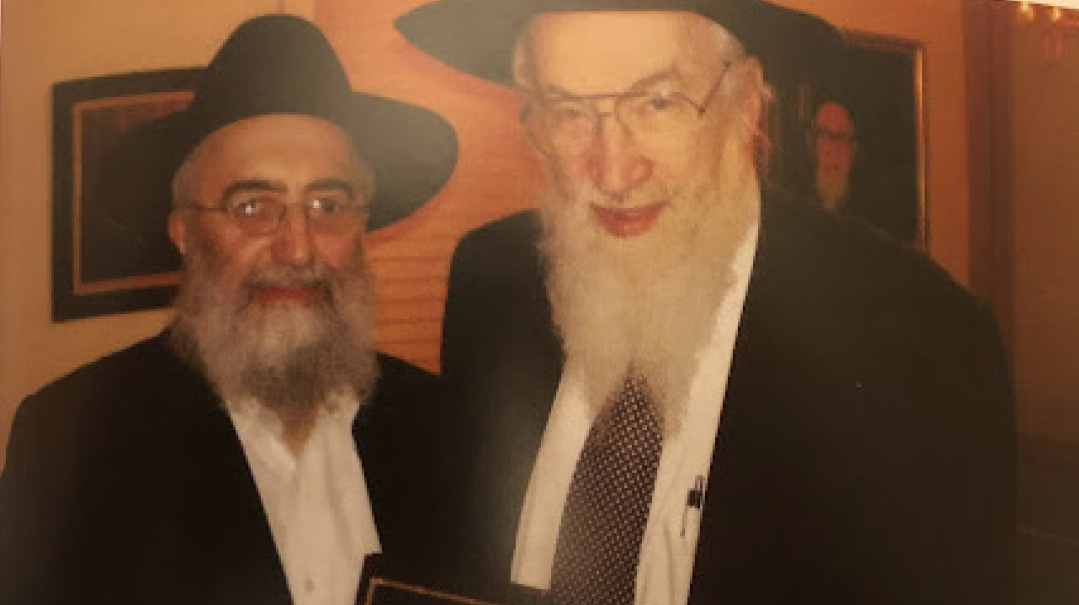
Rabbi Niyazov (left) presenting Rabbi Yisroel Belsky with his sefer on the mesirus nefesh of his community. “Not a single person can share our learning secret, not your friends, not your neighbors, not your parents”
“Who taught you to read Hebrew?” demanded the informant, who was one of the shul’s gabbaim.
Rav Abramov, thinking quickly, pointed at another of the shul’s gabbaim — also a known informant — and said, “He did!”
But while the dangers of davening and learning Torah in secret were well-known by Bukharian Jews, organizing yeshivos for groups of bochurim entailed a whole new level of risk. Rav Hillel Saltzman, a Chabad rav who was heavily involved in the religious underground, writes that running an illegal yeshivah was dangerous on so many fronts that even closest family members were not informed of its existence.
One time, Rav Zaltzman recounts, while a clandestine Chabad yeshivah was housed in the home of Rav Dovid Mishulovin on Kommunisticheskaya Street, Rav Dovid’s brother-in-law Yakov came for an unexpected visit. Hearing his approach, the bochurim ran to hide in the basement. But their presence did not go undetected — Yakov heard noise from the basement and inquired what it was. “Mice,” Rav Dovid replied evenly. Even his brother-in-law could not be in on the secret.
Keeping a group of young men learning a secret was no easy task. In many locations, the bochurim were forced to remain in hiding until nightfall so as not to arouse suspicion. When neighbors began to notice unusual comings-and-goings in different houses throughout the city, Chabad organizers had to quickly find them new hideouts. At one point, when hideouts were scarce, bochurim learned in a small storage room in Rav Zaltzman’s apartment that had previously housed a different sort of resident — his parents’ pet goat.
When Rav Zaltzman — along with many other Chabad families — was able to secure an exit visa in the early 1970s and leave the USSR, the mantle of organized underground Torah study was taken up by local Bukharian rabbanim. Rabbi Shlomo Chai Niyazov, currently rav of Congregation L’Maan Achai Bukharim in Brooklyn, New York, came from a long line of Bukharian rabbanim and stepped in to fill the gap. Educated in clandestine Chabad yeshivos in the 1960s, Rav Niyazov had a fiery determination to continue Torah education in Samarkand at all costs.
Rav Niyazov’s mesirus nefesh for his community’s Yiddishkeit occasionally took a humorous turn. Once, when he was due to be baal korei at a secret minyan, he found himself in a military hospital — part of a weeks-long ordeal to see if he was fit for military service. Determined to make it to shul for davening, Rav Niyazov was able to broker a deal with his fellow patients: They would dress him in civilian clothing and help him escape over the hospital compound’s brick wall, and he in turn would bring a gift back on Sunday — a bottle of vodka.
The escape plan went without a hitch — until he arrived in shul, wearing the clothes provided by his fellow patients.
“Shlomo!” the gabbai confronted him, “What are you doing wearing bell-bottoms?”
The business of teaching Torah in Samarkand in the 1970s, though, was no joking matter. Rav Niyazov had to use all the ingenuity at his disposal to find trustworthy teachers, secure secret locations, and, perhaps most importantly — to recruit students. Rav Niyazov would frequent the marketplace to scout for Jewish children. But how to know if they were Jewish?
“I would approach a young boy and ask a religious question — usually whether his mother lit Sabbath candles at home,” Rav Niyazov writes in his book Defiance in Samarkand. “Non-Jewish children would answer with a puzzled look and walk away, but Jewish children would nod hesitantly.”
And in many cases, they agreed to join him for after-school classes about Yiddishkeit.
Discretion was of the utmost importance. “Not a single person can share our secret,” Rav Niyazov repeatedly warned his young charges. “Not your friends, not your neighbors, not your grandparents, and not your parents.”
Parents assumed their children were playing outside or doing homework with classmates during yeshivah hours. And due to the danger of discovery, locations were changed constantly: The students were shunted from basements to attics to hidden rooms, with their seforim hidden among their schoolbooks.
Despite all their precautions, though, the KGB was soon onto them. One day in 1973, two KGB agents cornered a student as he was on his way to the underground yeshivah. “Follow us,” they ordered, and brought him to an interrogation site.
“Just tell us one thing,” the police demanded, “Just this one thing, and we will let you go. Are you learning Torah with Shlomo Chai Niyazov?”
The boy, though terrified, denied everything. But the KGB had proof — pictures of the boy entering and leaving the clandestine yeshivah, with two-hour gaps between them. Trapped, the boy admitted the charge. The KGB repeated the stunt with another 24 students, and with the incriminating signatures on file, finally called Rav Niyazov in for questioning.
“‘We have signed proof from 25 boys who testified that you are illegally involved in teaching them Torah,’” the KGB officer challenged Rav Niyazov.
Rav Niyazov, attempting nonchalance, totally denied the claim. But they knew his guilt, and threw another tried-and-true maneuver at him: “‘If you confess and promise to never do it again, I will let you off with a warning,’” the officer smugly assured Rav Niyazov.
What happened next was a near miracle.
He then pushed a pen and paper toward me. “I will dictate and you will write: I, Shlomo Chai Niyazov, have committed the following crimes,” which he listed — among them, teaching Torah to children — and ended with, “I promise never to do them again.”
I took the pen, blocked out his voice, and wrote the following:
I, Shlomo Chai Niyazov, did not teach Torah to any children. Instead, I only taught them to read the Hebrew alphabet, the alef-beit, which is not against Soviet law. Any Torah that they know is from my grandfather, Gavriel Niyazov, who left the country [and thus could not be prosecuted] in 1972.
To Rav Niyazov’s utter astonishment, the officer took the paper, tossed it into a drawer, and did not even bother to check what Rav Niyazov had written on it. Rav Niyazov was free.
Rav Niyazov continued to organize underground Torah learning until his emigration to New York in 1978. His work, in turn, was continued by other Bukharian and Chabad rabbanim who remained in Uzbekistan until (and even after) the collapse of the Soviet Union.
Among those other stalwart rabbanim who stayed on in Uzbekistan was Rav Isak Abramov. With help from rabbanim in Samarkand, he began a yeshivah in his home in the nearby city of Bukhara, which sprouted into a vibrant religious community. And when the Soviet Union dissolved in the early 1990s, many of his early students made their way to New York and Eretz Yisrael, where they established Torah-true homes.
The kernel of inspiration for Rav Abramov starting his school came from a conversation in 1988, when he felt despondent about the state of Yiddishkeit in Buchara. He related the anecdote in a conversation with Mishpacha.
“In 1988, I was going to shul and walking with an elderly man. I said, ‘In a couple of years, nobody is even going to go to shul, nobody’s going to eat kosher, nobody’s going to do anything [Jewish].’
“So the old man said, ‘No. You know, the world is circular. There are times when it’s at its peak, there are times when it’s just on the bottom, when it’s being beaten, and buried. But remember — it’s a circle, it will still go up again. Don’t lose hope.’”
With thanks to Yehuda Geberer, Dovi Safier, Libi Astaire, and Mrs. Chaya Swerdloff for their help in researching this article.
Tzivia Meth is a mechaneches and Jewish history teacher at Shevach High School in Kew Gardens Hills, New York.
Sources:
The Torah World: A Treasury of Biographical Sketche; Toldos Chabad Be-Rusia Ha-Sovyetit; Becoming Soviet Jews: the Bolshevik Experiment in Minsk; Im Gedolei HaTorah B’Minsk — the Minsk Memorial Book; The Unconquerable Spirit: Vignettes of the Jewish Religious Spirit That the Nazis Could Not Destroy; Surviving the Holocaust: The Kovno Ghetto Diary; Sefer Yasor Yisrani; Samarkand: The Underground with a Far-Reaching Impact
(Originally featured in Mishpacha, Issue 978)
Oops! We could not locate your form.







